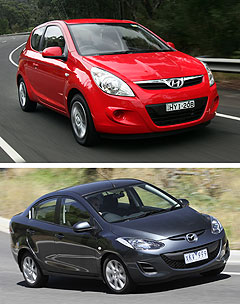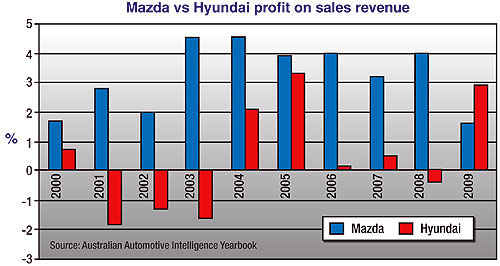Make / Model Search
News - General NewsHyundai profits from push upmarketMovers: Mazda and Hyundai are increasingly eye to eye in the Australia new-car market. Hyundai ‘hare’ lines up against Mazda ‘tortoise’ in sales – and profitability31 Aug 2010 MAZDA and Hyundai are two of the most watched car importers on the Australian market. Separated by just 0.2 percentage points of market share – Mazda 8.2 per cent share to Hyundai’s 8.0 per cent – after seven months of showroom showdowns this year, both companies are in with a chance of snatching third place in the market if Ford Australia fails to get a wriggle on. Last month, Mazda came within one unit of tipping former owner Ford out of its long-held third spot, and few would bet against Hyundai reaching the podium in the medium term. Although the two importers have never been considered natural rivals, with ‘tortoise’ Mazda building its Japanese premium position compared with ‘the hare’ Hyundai’s cheap and cheerful proposition, the gap is narrowing. Hyundai unashamedly wants to emulate the Japanese makers and – like almost every product coming from Korea these days – is making major headway in both quality and ‘bang for buck’. Think Samsung versus Sony. The common perception in Australia, particularly in the motor trade, is that Hyundai has been buying share of the Australia motor market, using its relatively cheap manufacturing base in Korea – and now India – to make motorists an offer too good to refuse while also eschewing profit for volume. Like most of the Japanese car-makers, Mazda has been fighting back on this front, drawing more models from its joint manufacturing base with Ford in Thailand where lower costs and a free trade agreement with Australia help to cut its offshore overheads.  Left: Hyundai i20. Below: Mazda2 sedan. Left: Hyundai i20. Below: Mazda2 sedan.While we will never know the full story on supply costs – they are not only carefully guarded secrets but hugely complex – we can look at the financials on the Australian side to get some clue as to the mindset of the two protagonists. For two decades, Mazda Australia has been a model of profit consistency, finishing in the net-profit red only four times in that period. A more interesting way of looking at the profits is the return as a percentage of sales revenue. More often that not, Mazda has returned between two and four per cent on sales revenue, peaking at 4.5 per cent in 2004, when it made a record $54 million net profit (although a change to the company’s financial year confused matters). Through the ‘noughties’, its return has averaged about 3.0 per cent, dipping to 1.6 per cent in the financial year ending in 2009 after taking a hit from the global financial crisis. Hyundai, on the other hand, has fluctuated more readily, dipping into the red six times in the past couple of decades. Its best result was a $28.5 million net profit in 1996, when it was being distributed by an independent importer. Back then, in the mid-1990s, Hyundai’s percentage return on sales revenue in Australia topped out at 5.8 per cent in 1995, closely followed by 5.7 per cent in 1996. In the late-1990s, however, the Hyundai profit took a hammering, and for five out of the six subsequent years Hyundai’s profit return on sales revenue was negative. It was not until head office took control of the local operation in 2004 that the company got its nose back in front. Since then, Hyundai has drawn a profitable percentage – if only a small one – in all but one year (2008). Its best return under factory control was 3.3 per cent in the financial year ending 2005, but last year it came back from a rocky 2008 to lock in a 2.9 per cent profit on revenue – just when many other importers were booking major dips, even major losses, as they tried to stabilise sales while riding out the GFC. It is no coincidence that Hyundai’s sales were also soaring in 2008-09, swimming against the GFC tide as buyers looked to the budget brands, which allowed the company and its dealers to pocket a healthier margin. It has been a long haul for many of those dealers, who have been largely reliant on F&I (finance and insurance) sales and spare parts business to make ends meet. For them, the move into more sophisticated territory is a welcome advance – one that takes the brand one step closer to Mazda and its premium position. The question is whether Hyundai will settle for slow progress as it nears a podium sales finish, or continue to shovel on the coal.  |
Click to shareGeneral News articlesResearch General News Motor industry news |









Facebook Twitter Instagram